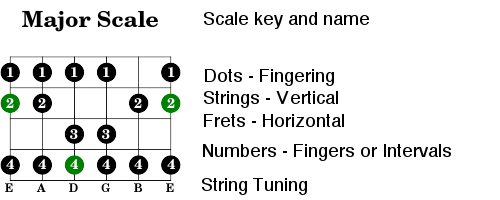Understanding Scale Diagrams

Scale Legend
Scale Name - The very top label of the scale diagram names the Key and the scale type.
Black and Green Dots - The dots on the scale diagram represent the fingers of your fretting hand. Each dot shows the scale sequence from lowest to highest. Only one dot or finger plays at a time. The green dot is the root note or name of the scale key. The numbers inside the dot represent the finger of your fretting hand or the interval of the scale. Fingers ( Index = 1, Middle = 2, Ring = 3, Pinky = 4, Thumb = T )
Fret Numbers - The numbers listed vertically on the left side of the fretboard represent the frets you should place your fingers on to play the scale correctly.
String Letters - The letters at the bottom of the string represent the open pitch of the string. This helps to identify the tuning of the instrument.
Root notes - The green dots are root notes. This means that the scale is moveable and by shifting up or down the fretboard you can change the key of the scale without changing the scale type or pattern. This brings out the true power of scales on stringed instruments. Learn 1 scale pattern or type and you know them all. You just have to put it on the right fret to match the key you want.